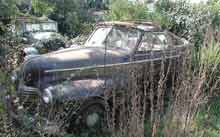We Do Windows
You've seen this car before. It was in the way when Wayne Graefen went to retrieve "Ivy," his 1932 Plymouth convertible sedan. At last report, it was still sitting in the same Southern California rest home for old automobiles. Wayne notes that it's the convertible coupe style without side windows for the rear passengers.
That set me to thinking. When did rear side windows appear in convertibles and why? I think I know why (better view for the back seat crowd), but it took a bit of research to figure out when. In the beginning, of course, there were was no reason for the windows, as back seat passengers rode outdoors. With the advent of the indoor back seat, the convertible's top was merely extended to cover them. These '37 Fords illustrate the difference.
The first convertibles to use side windows as we now know them, winding down into the side walls, were the "big" Mopar makes, Dodge, DeSoto and Chrysler in 1941. Plymouth, however, continued to use the "blind" style top that year, and right on through 1948. (Dodge devotees will remind us of the Wayfarer, the 1949- 1950 three-passenger roadster, that of course needed no rear windows. Curiouser was this three-passenger Chrysler Town & Country convertible, apparently advertised but perhaps never built?
Ford Motor Company makes made the switch in 1942, including the Lincoln-Zephyr but excepting the Continental, whose blind quarters were a styling feature and continued through to 1948.
As it turns out, our feature car was the last of its breed, as Pontiac, with all of the other GM brands, installed rear windows for 1942.
You might ask, "What's the big deal about those windows? Why didn't everybody start using them at the same time?" Well, there's more to them than meets the eye. In order to make them retract it's necessary to re-engineer the whole body, providing space for the window when it's down and a lowering mechanism that pivots the glass so as to obviate a center pillar. The independent manufacturers, understandably, took longer to put this into practice. Packard continued their blind quarters through 1942, then built no convertibles at all in 1946 or '47. The first "rear-side-window" Packard convertibles came with the "Pregnant Elephant" models starting in 1948. Studebaker, curiously, offered no convertible coupes in the late 1930s; the last pre-war open cars were the convertible sedans of 1938 and '39. Post-war, the first convertible was the 1947 model. Nash took even longer. The blind quarter style, like this '39, re-appeared in 1948 with Nash's first postwar convertible, then disappeared again. The next Nash convertible was the 1950 Rambler, whose side windows didn't disappear at all. The first "Nash product" with "conventional" side windows was the 1961 Rambler American convertible.
Hudson's approach to windows was evolutionary. In 1937, Hudson offered two types of convertibles, the "Convertible Coupe" with blind quarters, and the "Convertible Brougham" with rear side windows (Terraplane models shown). The single rear passenger in the Convertible Coupe rode sideways. The Brougham evaded the engineering problems of the windows by making them part of the top, a sort of side curtain that was removable when the top went down. Starting in 1941, you could order Hudson convertibles with or without glass rear side windows. The rear windows did not crank down, however, they lowered with the top. This arrangement prevailed until 1947. Lest we think Hudson incomparably clever, however, I remind you that Bantam had a similar option in 1940.
If you'd like to rescue that '41 Pontiac Deluxe Torpedo Six, the CarPort can put you in touch. It comes complete with bees in the side pocket.

